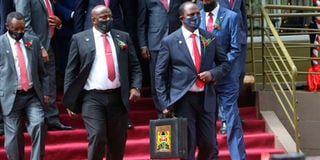Kenya’s launches global campaign for fourth Eurobond

National Treasury CS Ukur Yatani (holding briefcase) makes his way to Parliament for budget reading on June 11, 2021.
Kenya has kicked off a global roadshow for a fourth Eurobond in under seven years as it moves to raise additional billions of shillings to support its budget and repay maturing loans.
Though it is not clear how much the country plans to raise, the National Treasury indicated in past documents to the International Monetary Fund (IMF) that it will raise about Sh253 billion ($2.3 billion) in commercial borrowing (Eurobond) for project financing in the new financial year.
To fund the new Sh3.6 trillion budget for the financial year starting in July, the Treasury plans to borrow a total of Sh929 billion from local and foreign sources to plug the deficit.
Treasury Secretary Ukur Yatani said he would borrow Sh271.2 billion from international markets and another Sh658.5 billion from domestic markets. The Treasury also has an extra Sh609 billion debt redemption bill for the year, which will see it borrow to repay maturing debt.
GDP rebase plan
A preliminary prospectus shared with investors shows that the country also plans to rebase its gross domestic product in the coming months. This promises to expand the economy and in return make Kenya’s debt-to-GDP ratios look better.
This will be the seventh time Kenya is revising the national account statistics. In September 2014, the Kenya National Bureau of Statistics rebased its national accounts, changing the base year from 2001 to 2009, and revised the annual and quarterly national accounts statistics for the period 2006 to 2013.
The first revision was carried out in 1957 and subsequent revisions made in 1967, 1976, 1985, 2005 and 2014. The next rebasing is expected to take place later in 2021.
“The UN Statistical Commission recommends that countries rebase every five years. Rebasing enables economic estimates to better understand the current structure of the economy and sectoral growth drivers, and to better reflect the performance of the most important parts of the economy,” the Treasury says in the prospectus.
“For example, the rebasing in 2014 allowed the government to account for changes in production structure, relative product prices and products. These measures have led to changes in the size of GDP, growth rates, contributions by sector and related indicators that use GDP.”
The government has retained Citigroup and J.P. Morgan, which were involved in the previous three issues, as the joint book runners of the new Eurobond offer. I&M Bank Ltd and NCBA Group Plc are the new co-managers of the bond.
The Treasury said in April that it would use proceeds from a fresh Eurobond to retire expensive loans and refinance older Eurobonds, if it fails to secure cheaper concessional loans.
“With regards to the Eurobond, we have plans to access the international financial market for two reasons. One is to refinance some of the expensive debt,” said Dr Haron Sirima, the director-general of the Public Debt Management Office at the Treasury.
The second reason the government is contemplating accessing international financial markets, he said, was that in the event the Treasury does not get cheaper credit elsewhere, it will have to go for another Eurobond to repay previous Eurobonds.
Kachumbari bond
Kenya went for its first Eurobond in June 2014, when a total of Sh280 billion was borrowed in five and 10-year tranches. This is the Eurobond that gave former auditor Edward Ouko grey hair as he unsuccessfully attempted to track its usage down to the projects.
The government went back for another Eurobond in 2018, netting Sh202 billion in 10 and 30-year tranches.
In 2019, Kenya was back in international markets, raising Sh210 billion in its third Eurobond, named the Kachumbari bond, which also repaid other loans and funded unspecified infrastructure projects.





